Latinx diversity work is about campus transformation, not initiatives
UC Berkeley leaders are reimagining what a Hispanic Serving Institution really means for campus
October 11, 2022
When UC Berkeley Chancellor Carol Christ, in fall 2018, announced that the university would begin the process of becoming a Hispanic Serving Institution (HSI) — having at least 25% of enrolled undergraduate students who identify as Latinx — it was a bold statement that challenged the campus community to reimagine what that would mean for Berkeley.
And for campus leaders Lisa García Bedolla and Fabrizio Mejia, growing Berkeley’s Latinx community is not just about getting a federal designation, but about transforming campus — its culture and resources — into a place where Latinx students feel like they belong.
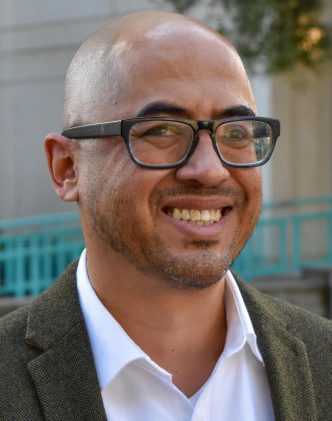
Fabrizio Mejia
“Students want institutional change and transformation. They want their experience to be different,” said Mejia, Berkeley’s assistant vice chancellor for student success, equity and inclusion. “HSI is still important, but it is just a marker that we’re moving in the right direction.”
A Berkeley HSI Task Force Report showed that in 2019, over 50% of California’s public high school graduates identified as Latinx. Berkeley’s incoming undergraduates that same year were just 16% Latinx — not even a third of the Latinx student representation in the entire state.
As co-chairs of Berkeley’s Latinx-Thriving Institution (LTI) Initiative Steering Committee, García Bedolla and Mejia, who are Berkeley alumni, hope to change those numbers on campus by shifting the narrative and implementation of HSI to a “thriving” framework: Where the focus is not on making sure Latinx students are ready for Berkeley, but that Berkeley is ready for them.
The committee will launch an implementation team this month — composed of students, staff and faculty — that will begin the arduous work of turning the data, and campus recommendations, into policy and practice that will serve Berkeley’s growing Latinx community.
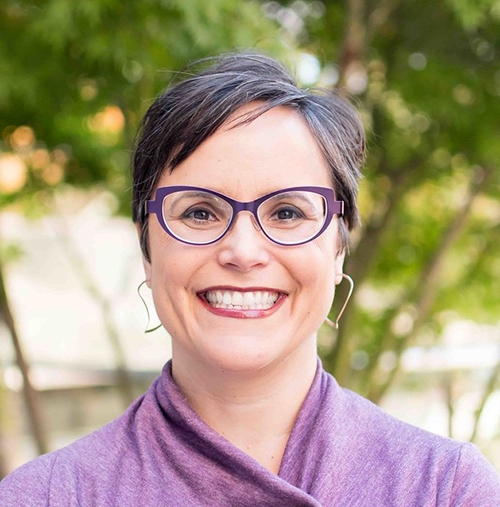
Lisa García Bedolla
“Berkeley is an incredibly large, complex institution, and we’re trying to do something that touches all aspects, both the academic and administrative sides of the house,” said García Bedolla, a Berkeley professor, vice provost for graduate studies and dean of the Graduate Division. “That’s very difficult to do within our structures. … But I think that’s why it’s our obligation to do this work. To build trust by saying what we mean, and doing what we say.”
Berkeley News spoke with García Bedolla and Mejia recently about why honoring the history of diversity work on campus is important, and why Berkeleyans who aren’t a part of the Latinx community should care about this initiative.
Why transition away from calling the initiative Hispanic Serving Institution (HSI) to Latinx- Thriving Institution (LTI)?
Lisa García Bedolla: That transition is really about saying that this isn’t just about a number. This is really about rethinking our work institutionally, administratively, intellectually and pedagogically.
If we have disparate outcomes across our students, it’s not some idiosyncrasy of theirs. So, if we believe capacity is not differentially distributed by race, then by definition there’s something going on with the institution’s structure, not the students.
We really want to think about what it would take to not only admit those students, but make sure they thrive. The way I like to think about it is, Diversity 1.0 was letting more folks of color, like me, attend elite institutions of higher education.
But the institutions themselves didn’t change all that much.
So, if you think of the programming that was developed in the 1980s and ‘90s, it was a deficit framework. In order to address any gaps students were experiencing, the focus was on “fixing” the student, not Berkeley. LTI makes a really important pivot of what I would call Diversity 2.0, which is thinking about how the institutions actually need to change in order to be, as (Fabrizio) puts it, “student ready.”
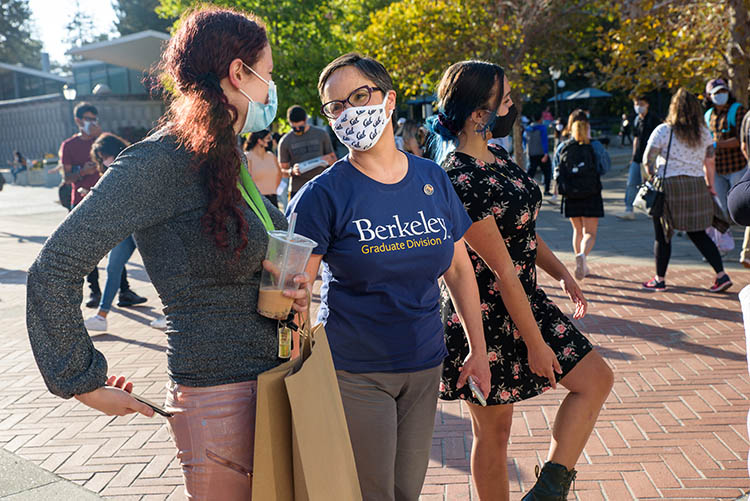
Lisa García Bedolla, center, at Berkeley’s graduate student welcome event last fall. “We really want to think about what it would take to not only admit (Latinx) students, but make sure they thrive,” she said. (Photo by Shoey Sindel)
Fabrizio Mejia: And I think students, when we explain what we mean by that, they get it, and that’s what they want. They want institutional change and transformation. They want their experience to be different.
And every single intersecting point that this institution has, we stand with our communities. HSI is still important, but it is just a marker that we’re moving in the right direction.
What we’re doing is taking the data — and the experiences we’ve heard from the community — to the deans and chairs and offices across campus to show them what’s happening in our Latinx community. And we’re saying, “Help us understand how we can support you in changing” this particular factor, or that data point.
And so, that way, it’s not one office or one division doing the work of equity. It’s everyone beginning to take on the transformation of the environment collectively, so that different communities can feel a sense of belonging and engagement.
Why is this important for people on campus who are outside of the Latinx community?
FM: Well, the Latinx community is not a monolith. They’re intersectional. We have low-income, first-, second- and third-generation students, graduate students, and we have students that are not just Mexican.
So, it’s in making sure that they see themselves in that intersectionality, and that the services that they need at the particular time are there for them, and are open to them. And many of the specific services they need are not specific to the Latinx community, but are open to a lot of other communities, as well.
There are certain resources that Latinx folks are identifying that are pretty consistent across the different initiatives. Counseling and Psychological Services, for instance, is about access to culturally relevant mental health and wellness support services, and that spans across so many communities.
Everybody on campus talks about affordability, as well. So, there are certain things we’re learning that need to be fixed so that all boats rise. But there are other things that are specific to the Native community, Asian Pacific American community or the Latinx community, and that’s the equity aspect of the work — let’s absolutely work on those, too.
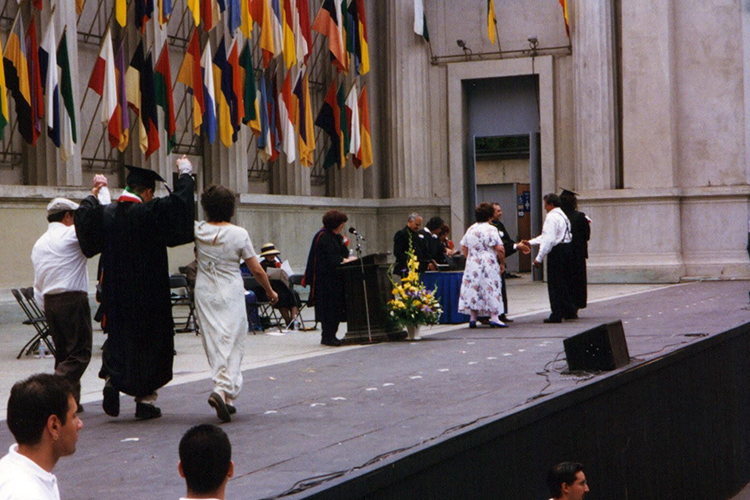
Mejia raises his hands with his family in 1997 as he walks across the stage at Berkeley’s Latinx graduation. “At every single intersecting point that this institution has, we stand with our communities,” he said. (Photo courtesy of Fabrizio Mejia)
LGB: Also, we’ve really been very mindful of trying to get out of a zero-sum sort of mindset. That somehow helping one group means a negative for another group.
Figuring out how to serve one community — in this instance, the Latinx community — allows us to improve our ability to serve others. And I think it’s important to note that we also have the African American Initiative, we have the Native American Initiative that was just launched, and folks are talking about Asian American Pacific Islander students and how to support them. And so, I think the challenge of this moment is how to address this global umbrella of communities we have.
And those are things our implementation committee hopes to address, as well.
What are some goals of the implementation committee?
FM: There are a lot of recommendations we are looking to address. But enhancements in recruitment, admissions and matriculation are something the committee will be focusing on.
We want to change the relevant outreach methods, whether it’s the way we communicate in different languages or putting more effort into proactive outreach at institutions, high schools and community colleges that will help us grow competitive Latinx applicants.
We also want to rethink summer opportunities for students that get admitted. Expanding the theme programs and residential floors for Latinx students to come on campus and start off with a great experience. Growing resources like the Educational Opportunity Program and opening the Latinx Community Center are all part of the recommendations, but it’s also a sustainable model, in a sense, that we want to ramp up particular resources that we know work.
The data show a large proportion of Latinx students use the Basic Needs Center for resources like CalFresh, the food pantry and/or housing programs. And that makes sense when you look at demographics around Pell Grant status.
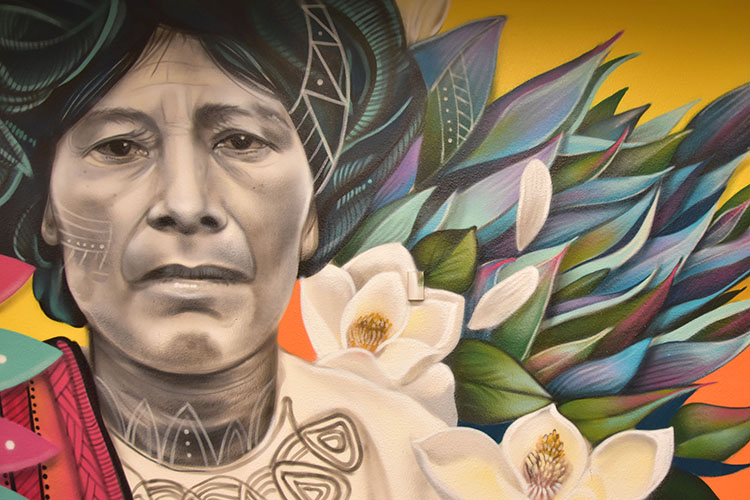
In the Basic Needs Center, a section of a mural by street culture artist and muralist Victor “Marka27” Quinoñez depicts an elder from Oaxaca. Mejia said a large proportion of Latinx students use the center for resources. (UC Berkeley photo by Hulda Nelson)
We also see sizable percentages of Latinx students using the Transfer Student Center, and to have specific staff there for the LTI caseload will be essential to service those students and keep them proactively engaged when they get to Berkeley.
These are just some initial policy and practice changes we are looking at, but it is just the beginning.
LGB: It’s also important to recognize that we are still committed to diversifying Berkeley’s faculty pool. That is evident by the Latinx faculty cluster hires we have recently made and will continue to do.
It is important for students to have mentors and professors that can relate to their own lived experiences. And representation can make a big difference.
Does Berkeley have the resources to pull off this type of transformation?
LGB: Resources are important and are always a challenge to obtain. So, we need to be creative and do our best to raise new funds, whether they be philanthropy or private foundations and corporations. Whatever places we can find support I think we should consider, so long as it’s in alignment with our values.
But I actually think the more important resource is going to be the refocus and repurposing of what we already do. A lot of this isn’t about, “Do we need more advising in Berkeley?” Yes, obviously, for everybody. But could we maybe make our advising more culturally competent? Could we perhaps really incentivize advisors to do training? And many of them are already doing this, so this is not a criticism of our advisors.
But can we think about making sure everyone is aligned with this effort? Can we think about making sure that those folks are given the tools to make those changes? And to make sure they’re doing their work according to the most transformational practices that are available.
I think it’s really about looking at the whole institution and where we’re dedicating resources already, and seeing how we can deploy those more explicitly and intentionally in support of our goals.
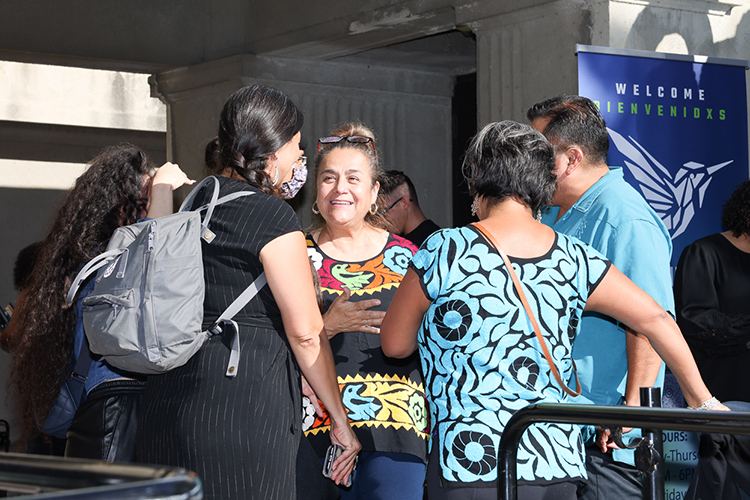
Director of Berkeley’s new Latinx Community Center, Lupe Gallegos-Diaz (center) greeted hundreds of students, staff, faculty and alumni who attended the center’s grand opening on Sept. 28. (Photo by Raul Hernandez)
FM: Also, I think this is going to be a phased process. Especially in a place like Berkeley, evidence is important. And I think we often have to make the case for more space and/or resources in a way that the administration can fully understand.
So, the more our resources and spaces are being utilized by our students, the more data we have to go through the budget process and say, “Hey we’ve outgrown, for instance, the Latinx Community Center, and we need a bigger space in x amount of years.”
And that’s part of the way we’re able to also grow the ecosystem. But there’s not one silver bullet yet to get there.
How will you measure success?
LGB: There really is no blueprint for what we’re trying to do. But we need institutional research, and qualitative data from students, to really get a sense of what is working and what isn’t.
As we move into the implementation process, we will identify baseline goals for the policy changes to make sure in Year Two, Three or Five, we can look at the data and evaluate whether or not student experience is better, or if we need to adjust certain practices or policies.
How do you deal with institutional cynicism around work like this?
FM: I think acknowledging the history of this work is paramount because it shows that things can change and transform.
At Berkeley, you started seeing this work come up in the literature around the 1960s, from the GI Bill and the kinds of students that had opportunities to come to a place like Berkeley. Faculty, staff and students organized for all of the resources, spaces and departments that we currently have.
So, it’s about giving all the credit to our ancestors — and all those that did the work — but also knowing that our job is to keep moving that ball along, and then to hand it off.
And we’ve got to continue to bring people along because if the work stops when certain people leave, then we didn’t do our due diligence in creating systems that are not single points of failure.

Supporters of the Ethnic Studies 50th anniversary rallied in January 2019 to pay homage to the Third World Liberation Front. Mejia said historical movements at Berkeley paved the way for departments and spaces that still exist today. (UC Berkeley photo)
LGB: I think it’s also important to acknowledge that hope is hard. It’s easier to be cynical, in some ways. It’s easier to not have any expectations because then you’ll never be disappointed.
And so, I think that’s why it’s our obligation to do this work. I think Vice Chancellor Dania Matos has been very good about being transparent, to listen, be open to feedback and highlight the small wins.
So, I think the best way to counteract cynicism is through building trust. And you build trust by saying what you mean and doing what you say. And so, I think that’s what we’ve been trying to do.
But I think being very mindful that getting people to be hopeful is an incredible responsibility that requires follow-through.
How should Berkeley’s campus community stay engaged in LTI work moving forward?
FM: We really want to make sure that the campus community knows that they’re invited in.
We want everyone.
We don’t have the ability to contact everybody individually, but there is an open invitation to engage and to contribute and to give feedback and make suggestions.

Berkeley’s Vice Chancellor for Equity and Inclusion Dania Matos’s office has led the LTI initiative, offering listening tours to engage with the campus community. (Photo by Brittany Hosea-Small)
We will also continue to share specific resources and examples of how segments of our campus (faculty, deans and chairs, students, alumni, staff, etc.) can take action to engage in this work. We invite everyone to go to the hsi.berkeley.edu website for the latest information and resources.
LGB: Berkeley is an incredibly large, complex institution, and we’re trying to do something that touches all aspects, on both the academic and administrative sides of the house. That’s very difficult to do within our structures.
But we’re trying to build something that no one has ever attempted at an elite research institution like Berkeley. So, there isn’t a blueprint, there isn’t a foregone conclusion of how this is going to go.
And I think the most important gift that students give us is urgency.
They keep us honest because their time horizon is much shorter than ours. The fact that they are constantly pushing us to be better, constantly pushing us to question things that perhaps we take for granted, is really important.
It’s not by accident that every social movement in the United States has been led by young people. We need that energy for this to be successful, and for people to actively think about what this means for them in their work.
To provide feedback and get engaged in the Latinx-Thriving Institution Initiative, contact the steering committee at [email protected].